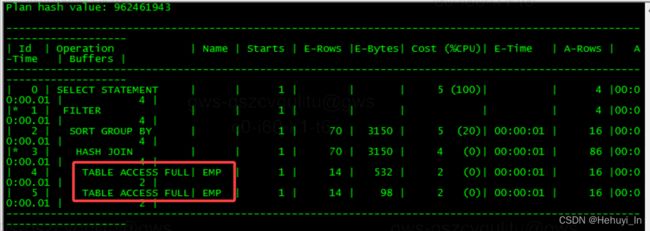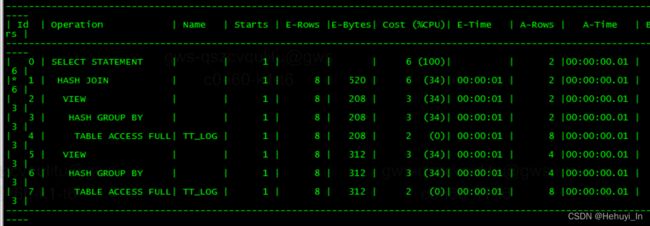Oracle 最值的优化 -- 利用分析函数改写
以下案例及写法来自 triger liu《专题培训-SQL写法与改写》,有部分个人测试及删改,原文请参考原课程。
一、 最值在表关联中
1. 低效且有重复值的写法
找出各部门工资最高的员工信息
select a.EMPNO, a.ENAME, a.JOB, a.MGR, a.HIREDATE, a.SAL, a.COMM, a.DEPTNO
from emp a,
(select deptno, max(sal) as max_sal from emp group by deptno) b
where a.deptno = b.deptno
and a.sal = b.max_sal
order by DEPTNO
这个SQL有两个问题:
- 如果每个部门是最高工资的不止一个人,上面查询会有重复数据。如果每个部门最高工资只要取一个人,这个写法就是错的。
- emp 表扫描了两次,效率低
2. 高效且有重复值的写法
等价改写是使用max()分析函数,改写之后依然有重复值,但是emp表只扫描一次。如果确实是需要重复值的,就用这个方法改写。
select empno,ename,job,mgr,hiredate,sal,comm,deptno
from (select a.empno,a.ename,a.job,a.mgr,a.hiredate,a.comm,a.deptno,a.sal,
max(sal) over(partition by deptno) as max_sal
from emp a)
where sal = max_sal
order by deptno;
- 数据不去重
- emp表仅扫描一次
分析函数除了最常用的row_number,其实还有很多种,在不同场景下可以发挥妙用。
3. 高效且去重的写法
需要使用row_number分析函数
select *
from (select a.empno,a.ename,a.job,a.mgr,a.hiredate,a.comm,a.sal,a.deptno,
row_number() over(partition by deptno order by sal desc) as rn
from emp a)
where rn = 1
order by deptno
- 数据去重
- emp表只扫描一次
4. 实际案例
凌晨CPU炸裂,查看top cpu sql,发现就是类似的语句,单次执行超过4万秒
如果是想取各个product_code最大global_version的信息,这个写法会有重复的数据
可以用分析函数改写,最后这个order by不需要也可以不排
改写后1.5秒出结果,cpu消耗基本没有了
二、 最值在where条件中
还是找出各部门工资最高的员工信息,但我们这次换个写法
select a.empno,a.ename,a.job,a.mgr,a.hiredate,a.comm,sal,a.deptno
from emp a
where sal = (select max(sal)
from emp b
where b.deptno =a.deptno)
order by deptno;
注意蓝色部分虽然没有写group by,但它的实际含义就是按deptno分组取最大值,所以如果改成分析函数一定得记得加 partition by deptno
你会发现问题是一样的:
- 数据不去重
- emp表扫描两次
它的改写方法跟前面的一样的,这里不重复了
三、 取最值的最值
1. 测试表构造
create table TT_LOG(ID int,SYNC_DATE int,JOUR_NO int);
insert into TT_LOG values(333,1,4);
insert into TT_LOG values(333,2,3);
insert into TT_LOG values(333,2,2);
insert into TT_LOG values(666,2,5);
insert into TT_LOG values(666,2,3);
--插入些重复值
insert into TT_LOG values(666,3,4);
insert into TT_LOG values(666,3,4);
insert into TT_LOG values(666,3,2);
commit;
2. 原SQL
根据ID分组,取 SYNC_DATE 最大值,再取最大SYNC_DATE对应的最大 JOUR_NO。
SELECT B.ID, B.SYNC_DATE, B.JOUR_NO
FROM
(SELECT ID, MAX(SYNC_DATE) SYNC_DATE
FROM TT_LOG
GROUP BY ID
) A,
(SELECT ID, SYNC_DATE, MAX(JOUR_NO) JOUR_NO
FROM TT_LOG
GROUP BY ID, SYNC_DATE
) B
WHERE A.ID = B.ID
AND A.SYNC_DATE = B.SYNC_DATE;
上面的SQL虽然实现了功能,但扫描了两次 tt_log 表,效率较低。
3. 改写
事实上可以直接用分析函数实现该功能:根据ID分组,根据 SYNC_DATE和JOUR_NO 字段按分组排序,然后取最大值。
- 先看看取最大值前的数据是什么样的
SELECT ID,SYNC_DATE,JOUR_NO,
row_number() over(partition BY ID order by SYNC_DATE DESC,JOUR_NO DESC) rn
FROM TT_LOG;
对每个id值,按照 SYNC_DATE和JOUR_NO 倒序排序,并列出编号,其中RN=1的数据就是我们需要的。
- 加上取最大值
SELECT B.ID,B.SYNC_DATE,B.JOUR_NO
FROM
(SELECT ID,SYNC_DATE,JOUR_NO,
row_number() over(partition BY ID order by SYNC_DATE DESC,JOUR_NO DESC) rn
FROM TT_LOG
) B
WHERE rn=1;
数据正确,并且表只扫描了一次,更高效。
四、 一个复杂些的例子
1. 原sql
select count(*)
from jbpm_testtest1 t
join jbpm_testtest2 pi on t.procinst_=Pi.id_
inner join ccform_testtest3 d on d.cf_id = pi.id_
where ( t.end_= (select max(end_)
from jbpm_testtest1 s
where s.procinst_=d.cf_id
and d.cf_gdsta in ('K')
)
or (t.end_ is null and t.isopen =1 )
);
同样虽然求最值部分没有明着用group by,但因为它是在where条件中通过 procinst_ 字段关联,实际上就是对 procinst_ 字段分组求最值。
2. 比较直接的改法
直接把求max值部分提出作为临时表,然后改成关联(已经比原sql高效)
with V as
(
select procinst_,max(end_) as max_end_
from jbpm_testtest1
group by procinst_ -- 注意这里一定要有
)
select count(*)
from
( select t.procinst_,t.end_,t.isopen,d.cf_id,d.cf_gdsta,v.max_end_
from jbpm_testtest1 t
inner join jbpm_testtest2 pi
on t.procinst_=Pi.id_
inner join ccform_testtest3 d
on d.cf_id = pi.id_
left join v on
(d.cf_id=v.procinst_ and d.cf_gdsta in ('K'))
) where (end_ is null and isopen=1) or (end_ = max_end_ );
3. 改为分析函数
不要只想着把 jbpm_testtest1部分拆出来改为分析函数后再跟其他表关联,这里他们是一个整体。
- 所以第一步,先把它拆成 关联部分+条件部分
select count(*) from ( select xxxx from
from jbpm_testtest1 t
join jbpm_testtest2 pion t.procinst_=Pi.id_
inner join ccform_testtest3 don d.cf_id = pi.id_
) as tmp
where ( t.end_= (select max(end_)
from jbpm_testtest1 s
where s.procinst_=d.cf_id
and d.cf_gdsta in ('K')
)
- 第二步,把紫色部分看做一个整体,那xxxx部分应该是什么? —— 是where条件中的字段,所以把where条件中用到的字段挪上去
select count(*) from ( select t.procinst_,t.end_,t.isopen,d.cf_id,d.cf_gdsta,max_end
from jbpm_testtest1 t
join jbpm_testtest2 pion t.procinst_=Pi.id_
inner join ccform_testtest3 don d.cf_id = pi.id_
) as tmp
where ( t.end_= (select max(end_)
from jbpm_testtest1 s
where s.procinst_=d.cf_id
and d.cf_gdsta in ('K')
)
or (t.end_ is null and t.isopen =1 )
);
- 第三步,max_end 是怎么来的,就是通过分析函数,所以把这部分加上分析函数
select count(*) from ( select t.procinst_,t.end_,t.isopen,d.cf_id,d.cf_gdsta,
max(t.end_) over(partition by t.procinst_) as max_end
from jbpm_testtest1 t
join jbpm_testtest2 pion t.procinst_=Pi.id_
inner join ccform_testtest3 don d.cf_id = pi.id_
) as tmp
where ( t.end_= (select max(end_)
from jbpm_testtest1 s
where s.procinst_=d.cf_id
and d.cf_gdsta in ('K')
)
or (t.end_ is null and t.isopen =1 )
);
- 最后,既然已经有了max_end,where条件那个t.end=max(end_) 就可以替换掉了。当然,其他条件要保留
select count(*) from ( select t.procinst_,t.end_,t.isopen,d.cf_id,d.cf_gdsta,
max(t.end_) over(partition by t.procinst_) as max_end
from jbpm_testtest1 t
join jbpm_testtest2 pion t.procinst_=Pi.id_
inner join ccform_testtest3 don d.cf_id = pi.id_
) as tmp
where (end_= max_end and procinst_=d.cf_id and cf_gdsta in ('K'))
or (end_ is null and isopen =1);
最后结果
select count(*)
from
( select t.procinst_,t.end_ , t.isopen,d.cf_id,d.cf_gdsta,
max(end_) over (partition by t.procinst_) as max_end
from jbpm_testtest1 t
join jbpm_testtest2 pion t.procinst_=Pi.id_
inner join ccform_testtest3 don d.cf_id = pi.id_
) as tmp
where (end_=max_endand cf_id=procinst_ and cf_gdsta in ('K')) or (end_ is null and isopen=1) ;
参考
SQL优化经典----利用分析函数优化自连接_mengxiangfeiyang的专栏-CSDN博客
利用分析函数优化自连接_落落的专栏 专注SQL调优 性能调优-CSDN博客
用oracle分析函数优化自连接_kingtoon的专栏-CSDN博客
28 分析函数优化自连接,减少表访问次数 --优化主题系列_leo0805的博客-CSDN博客
第62篇-学习并分析“一次巧妙的SQL优化改写”

















